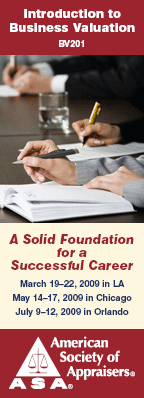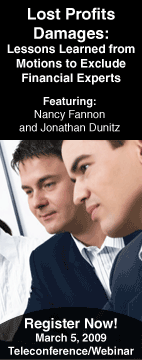
| Damodaran says Fair Value for financial reporting is flawed… Can it be fixed? Earlier this month, the Financial Accounting Standards Board’s Valuation Resource Group asked for additional guidance on Fair Value. Aswath Damodaran—the always candid Professor of Finance at the Stern School of Business at New York University and David Margolis Teaching Fellow—said he spent some time reading FAS 157, Fair Value Measurements and concluded that it is “a painful document to get through. No wonder you spend so much time reading it. It changes every time,” he told over 200 attendees at BVR’s recent 2nd Annual Fair Value for Financial Reporting Summit in New York City. Among the many problems with FAS 157: It does not say which among possible valuation perspectives—intrinsic values versus relative values, investment versus asset values—to apply in any given situation. “It gives no particular description of the ubiquitous market participant,” he said. “It says to consider liquidity, but not too much.” If Damodaran were made ‘accounting czar’ for one day—and “assuming I lived through that day,” he quipped—the Professor would operate the fair value for reporting system along these four points:
For those folks who, like the good Professor, may first want to take a fresh look at Statement No. 157 (or who may want their CFO and auditor clients to grasp its basic points), we’ve put together a free download, Summary of FAS 157, Fair Value Measurements, now available at BVResources. If you want a full report on Damodaran’s address on fair value—its flaws and possible fixes—make sure to read the next (April 2009) Business Valuation Update™. Financial crisis creates a greater demand for fairness opinions in both the U.S. and abroad, new data find The global financial crisis has triggered calls for transparency and accountability, with firms having to defend their decisions more frequently, according to data from Duff & Phelps’ recently released Fairness Opinion Survey. In fact, slightly more than two-thirds (68%) of the senior corporate executives queried for their views on the use of fairness opinions thought that boards of directors have become more concerned with potential shareholder lawsuits over the past five years. Additional data show that:
Want more information on fairness opinions? Later this summer, BVR will publish a new, comprehensive guide on fairness opinions that will be edited by Willamette Management Associates (WMA). In addition, the Winter 2009 edition of Insights, published by WMA, includes two must-read articles on the subject. One article, Factors to Consider in Performing a Valuation Analysis for a Fairness Opinion, authored by Craig Jacobson, is accessible online at willamette.com. The Pomeroy Bill: Share your thoughts on the potential impact of this proposed legislation When it comes to the Certain Estate Tax Relief Act of 2009, H.R. 436, there is a vocal majority among BV experts who contend that the bill could bring about the demise of the valuation of fractional interests in family owned investment entities. Nonetheless, it was surprising that our coverage of a position-taking article authored by William Frazier—vice-chairman of the American Society of Appraisers’ Government Relations Committee—prompted one reader to send the following Letter to the Editor:
What do you think? Read the Pomeroy Bill and share your views. Challenges to financial experts have more than doubled since 2000 PricewaterhouseCoopers’ recent 2000-2007 Financial expert witness Daubert challenge study examined 3,681 Daubert challenges to expert witnesses of all types in federal and state courts during the years 2000-2007 and found that “the number of per-year challenges rose from 251 in 2000 to 704 in 2007, an overall increase in spite of a slight dip in the number of challenges between 2006 and 2007 — 741 challenges in 2006 (an all-time high) versus 704 challenges in 2007.” The point: As we approach the ten year anniversary of the Supreme Court's Kumho Tire decision (originally decided March 23, 1999), the protection against challenges to a financial expert’s testimony, valuation opinions, and the appropriate measure of disclosures during the discovery process has become a topic of discussion that no BV expert can ignore—particularly as the full weight of the federal rules regarding the preservation and production of electronic evidence have started taking effect. Nancy Fannon, editor of the soon-to-be-released, The Comprehensive Guide to Lost Profits Damages: An Expert and Attorney Reference Book, and attorney Jonathan Dunitz, will host a 100-minute BVR teleconference, “Lost Profits Damages: Lessons Learned from Motions to Exclude Financial Experts,” on Thursday, March 5 at 10:30am PST / 1:30pm EST. The duo will examine the wealth of cases excluding financial experts, offer comprehensive analysis of how to use this knowledge to protect against motions to exclude, and includes a live Q&A with Fannon and Dunitz. Attendees can receive 2 CPE and 1.5 CLE credits. Listen to Fannon describe this event in her own words. For those who need more: Teleconference registrants who also purchaseThe Comprehensive Guide to Lost Profits Damages: An Expert and Attorney Reference Book, due out this Spring, will receive $100 off the price of the teleconference. To find out more or register, click here. A random observation on the state of the economy—and good news for BV experts The following notable quote—attributable to Peter Grauer, chairman of Bloomberg LP—was culled from a recent issue of Fortune in the magazine’s My Metric section, which features quotes about observations on the economy: “I’ve been looking at the use of Bloomberg services by government agencies worldwide. They are adding more Bloomberg subscriptions. That suggests to me that the regulatory environment will continue to become much more rigorous.” Good news, indeed… Top 10 things law firm clients hate about their bills (hint: many may sound familiar to BV practitioners) Although BV practitioners almost always factor in hourly rates during the project fee budgeting process, hourly billing is not the most common method of communicating fees to clients in the BV profession, data from our recently-released 2009 Business Valuation Firm Economics & Best Practices Survey show. Nonetheless, there are lessons to be learned for appraisal experts from a popular session at the Marketing Partner Forum—an annual gathering of law firm leaders and marketing pros from across the country. At this year’s gathering, Ivan K. Fong, Chief Legal Officer and Secretary with Dublin, Ohio’s Cardinal Health, Inc., offered the list of client grievances outlined below. Interestingly, the list—as outlined on legal business development consultant Larry Bodine’s Law Marketing Blog—offer insights that are just as appropriate for the business valuation profession. Consider Fong’s list of client grievances:
The prevailing lesson, of course, is that communication is critical. Each point offers essential “food for thought” for any expert looking to hold on to clients in this shaky economy.
|
To ensure this email is delivered to your inbox,
please add editor@bvwire.com to your e-mail address book.
We respect your online time and privacy and pledge not to abuse this medium. To unsubscribe to BVWire™ reply to this e-mail with 'REMOVE BVWire' in the subject line or click here. This email was sent to %%emailaddress%%
Copyright © 2009 by Business Valuation Resources, LLC
BVWire™ (ISSN 1933-9364) is published weekly by Business Valuation Resources, LLC
Editorial Staff | Advertise in the BVWire | Copyright Notice
|
|


